We may not have the course you’re looking for. If you enquire or give us a call on 01344203999 and speak to our training experts, we may still be able to help with your training requirements.
Training Outcomes Within Your Budget!
We ensure quality, budget-alignment, and timely delivery by our expert instructors.
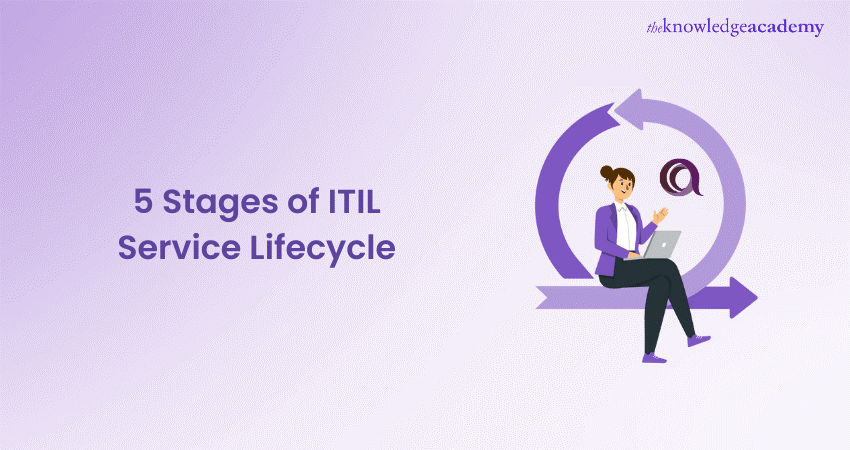
The Information Technology Infrastructure Library (ITIL) is a widely adopted framework for managing IT services and operations. ITIL Service Lifecycle comprises five distinct stages. Each stage represents a phase in the lifecycle of an IT service, from its initial conception to its retirement. In this blog, we will explore the five stages of the ITIL Service Lifecycle, understanding their purpose, key activities, and how they contribute to delivering value to businesses and customers alike.
By gaining insights into these stages, organisations can enhance their IT Service Management practices, improve service quality, and align IT services with business objectives effectively. Let's delve into the details of each stage and uncover the significance of the ITIL Service Lifecycle in modern IT service delivery.
Table of Contents
1) What is the ITIL Service Lifecycle?
2) 5 stages of the ITIL Service Lifecycle
a) Stage 1: Service strategy
b) Stage 2: Service design
c) Stage 3: Service transition
d) Stage 4: Service operational
e) Stage 5: Continual service Improvement
3) Benefits of applying ITIL Service Lifecycle
4) Conclusion
What is ITIL Service Lifecycle?
ITIL Service Lifecycle is a framework defined in ITIL v3 for managing a product or service throughout its lifecycle. It consists of five stages, each with its own specific processes: strategy, design, transition, operation, and continual improvement. It helps to align ITIL Project Management with business objectives and improve it continuously.
Five stages of the ITIL Service Lifecycle
The following make up the five stages of the ITIL Service Lifecycle:
Stage 1: Service strategy
ITIL’s Service Lifecycle's first stage provides guidance on how to build and use an IT infrastructure from scratch in a non-IT setting. This stage helps organisations to gain a competitive edge by helping them to choose the best practices.
The service strategy explains how to use IT services to accomplish an organisation’s business goals. The main purpose of the service strategy is to define the framework, techniques, and direction that a vendor needs to follow to meet the company’s business needs.
Purpose of Service strategy:
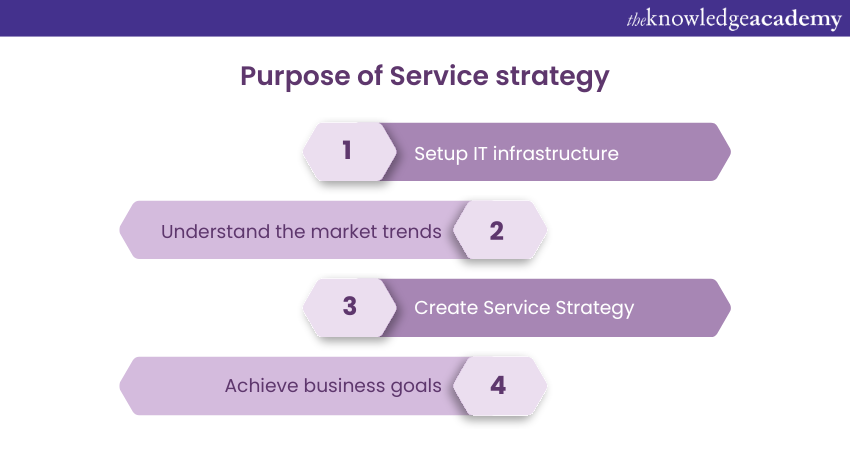
Maintaining a consistent Service strategy is necessary for organisations that provide customer service. It helps ensure that your service strategy aligns with the organisation's business needs. These business objectives should focus on a long-term approach rather than short-term fixes. This is where the ITIL Service Lifecycle plays a major role.
The organisation's IT strategies should be created in a way that supports the business strategies and does not hinder them in any way. At the same time, these strategies should be practical and easy to implement. You need to have an understanding of the following factors to devise such a strategy:
a) The ability of the organisation
b) The service provided
c) Customer’s needs
d) Necessary resources
e) Operating costs
Benefits of Service strategy:
From finding the latest trends to aligning with the trends, there are many benefits to implementing a service strategy. Some of these benefits are listed below:
a) Firstly, it helps create a customised strategy depending on the latest market trends that align with the business goals of the company
b) It helps provide a cheaper solution and, at the same time, does not compromise on the service quality
c) Staying ahead of the competition with a versatile approach to take corrective measures and fulfil the businesses' requirements
Signup for ITIL® Certification Courses and learn how to manage the Service Lifecycle from development to the improvement phase.
Stage 2: Service design
The second stage of the ITIL Service Lifecycle gives detailed instructions to create and produce the organisation's service and methods to handle these services. It also provides design guidelines and techniques for transforming tactical goals into services.
The organisation's service strategy should focus on the organisation's business goals. So, before designing it, you must ensure it aligns with the organisation's business goals. This stage is crucial for a business as it transforms a simple strategy into a viable plan to achieve business goals.
Purpose of Service design:
The main purpose of ITIL Service design is to create well-performing services that don't require a lot of upgrades in their tenure. Apart from this, the service design should focus on Continual Service Improvement and ensure that the services perform well throughout their lifecycle. Above all, constantly analysing the varying market trends to find better investment opportunities.
Benefits of Service design
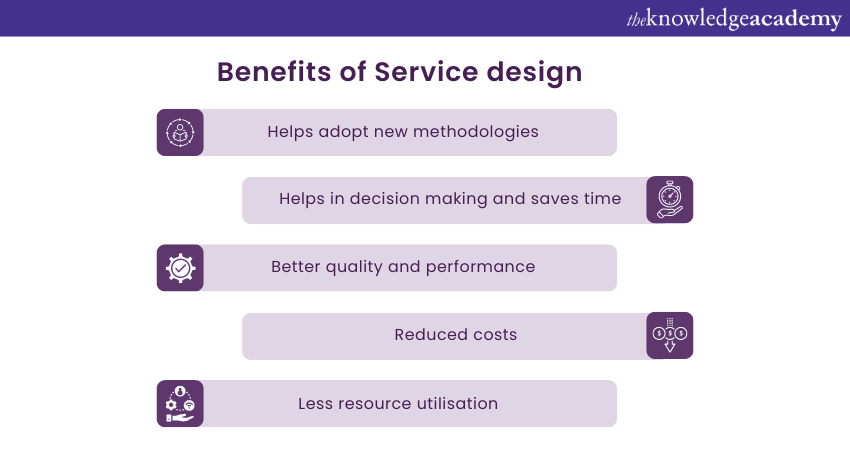
Your services can be superior and pocket friendly if they are designed well. A good design should also meet the business goals. Some of the benefits of ITIL Service Design are listed below:
a) A good design help adopts new methods and technologies easily
b) With a well-designed service, you can make better decisions and save a lot of time
c) Superior quality, better performance and consistency are the rewards of a good design
d) One of the most crucial benefits of a well-designed service is reduced cost.
e) It improves the performance of IT processes since fewer resources are required
Signup for our course on ITIL® 4 Strategist: Direct, Plan And Improve DPI and learn how to direct, plan and improve value streams.
Stage 3: Service transition
An organisation would include some elements in its strategy to enhance its current and future products and services before developing a new service. The main objective of the Service Transition stage is to make sure that the new and improved services meet the business requirements.
In the ITIL Service Lifecycle, the ITIL Service Transition stage aims to ensure the created services are ready to be used by the customers. Apart from this. This crucial phase also explicitly outlines the pivotal role of ITIL Service Management through the Service Knowledge Management System (SKMS). It helps improve learning in an organisation throughout the lifecycle of the service. It empowers employees with the hands-on experience of their peers and enhances the decision-making process.
Purpose of Service transition:
The main purpose of Service transition is to ensure that the implemented changes in service within the ITIL 4 Service Value System highlight the integral role of service transition in delivering value to the business. It also helps deliver the service releases in the right place.
Whether it's a newly released or modified service, it helps create practical expectations on the performance of these services. It helps to reduce risks to all the new, updated and terminated services. Above all, it helps learn the required knowledge and instructions on services and their resources.
Benefits of Service transition:
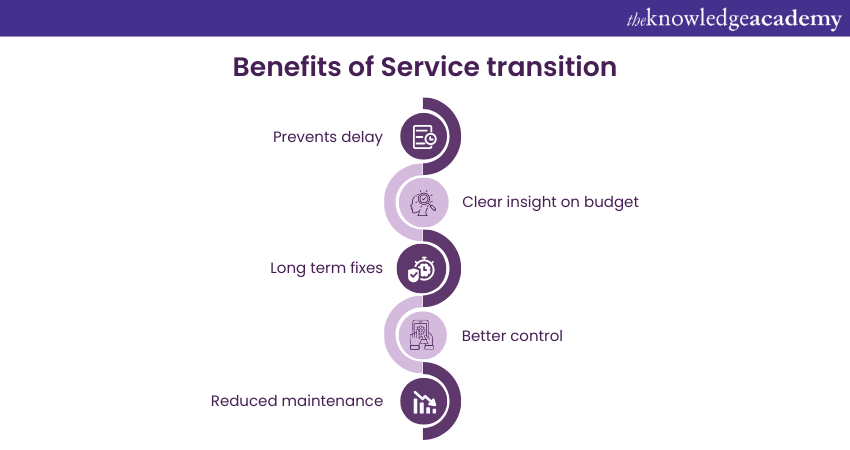
There are many benefits of the Service transition, and some of the benefits are listed below:
a) The Service transition gives a clear insight into the budget, the resources needed, the timeline for creating services and the overall risks faced by the organisation
b) It helps prevent unnecessary delays
c) It helps satisfy the stakeholder's expectations
d) It helps implement more changes
e) It requires minimum effort to manage testing with the help of service transition
f) It focuses on long-term fixes and significantly reduces the cost and maintenance required
g) It provides better control over various services, their settings and resources
Stage 4: Service operational
The operation stage in the lifecycle after the transition stage. This stage is focused on providing the services to the end users. In this stage, services are delivered with lower costs and risks. It includes actions and techniques required to offer the appropriate services to the customers and guarantee customer satisfaction.
Purpose of Service operational:
ITIL Service operation is a stage in the ITIL Service lifecycle that makes sure that the services the organisation delivers comply with the Service Level Agreements (SLAs). This is the goal of any business that provides customer services.
This stage includes gathering data, measuring work performance, and other important metrics. Besides this, it helps to keep an eye on the daily system activities to avoid any mistakes that could happen from the client side. It does this by responding to the user queries and feedback frequently.
Process of ITIL Service Operation:
ITIL Service Operation involves five processes that divide this stage into separate processes, thus increasing the effectiveness of this stage. These five processes are explained below:
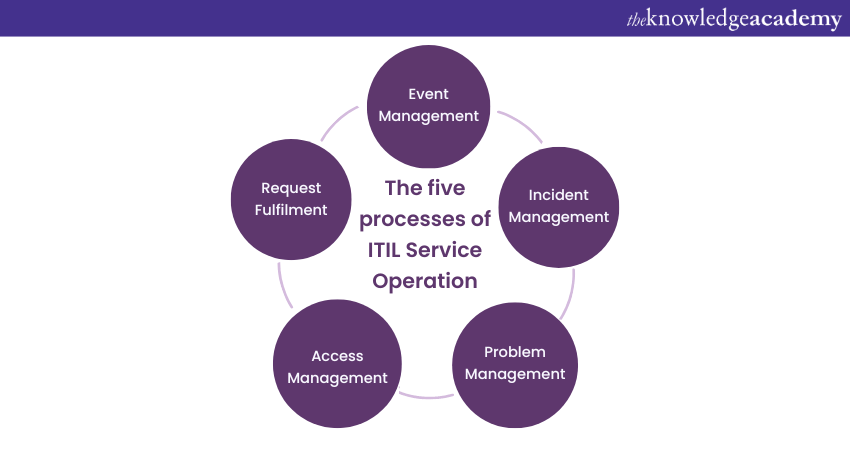
a) Event Management: This process identifies, and isolates events and responds to them. It contains a list of all the events by stored it it on a record.
b) Incident Management: At times, your organisation's service may get disrupted, leading to customer dissatisfaction. The ITIL Incident Management process helps overcome these disruptions and bring all the services into working condition.
c) ITIL Problem Management:It coordinates with Event Management and Incident Management to detect the primary cause of incidents. Doing this prevents these incidents from arising in the future, as appropriate measures are already in place. In the realm of ITIL Problem Management, these coordinated efforts highlight the crucial ITIL Problem Management roles and responsibilities of professionals involved.
d) Access Management: This is a crucial process as it could affect the security of the service. It helps provide access to people with proper authorisation and denies access to unauthorised users.
e) Request fulfilment: Once your service is released to the end-users, they may perform several actions, like creating a new account and password and changing the password, etc. These actions are called requests, and this process helps perform and manage such requests.
Benefits of Service operation:
The Service Operation stage has many benefits, such as lower cost and increased business value. These benefits are explained below in detail:
a) The operation stage manages service disruptions efficiently by addressing their root causes and hence lowers the unnecessary expenses.
b) It reduces the time span of service disruptions and occurrence so the end-user can use the service with minimal disruptions.
c) It collects useful data that can help improve the quality of the service.
d) Improves productivity by providing faster access to the IT services. Thus strengthening the ITIL Service Lifecycle.
e) It improves the security of a firm with its access management process by giving authorisation to the right users.
f) It facilitates automating repetitive tasks so the employees can focus on the essential tasks.
Stage 5: Continual Service Improvement
Continual Service Improvement (CSI) is a stage that aims to enhance the service by following quality assurance frameworks such as the International Organisation for Standardisation (ISO) 2000. This service applies quality management techniques to learn from past failures and successes. It concentrates on improving IT Services’ effectiveness and value by using customer feedback.
It helps to eliminate obstacles from the service and ensures it matches the client’s needs by using continuous evaluation. Frequent evaluation of the IT services can identify where it is deficient and areas of improvement.
Purpose of Continual Service Improvement:
Some of the purposes of this stage are listed below:
a) Examine and provide suggestions to improve all the stages of the ITIL Service Lifecycle.
b) Improve the performance of the IT services and save money at the same time.
c) Improving the quality and performance of the IT Service Management by detecting and executing certain tasks
d) Maintaining quality by implementing a quality assurance standard.
e) Cutting costs for delivering the service without negatively affecting the client's expectations.
Process of ITIL Continual Service Improvement:
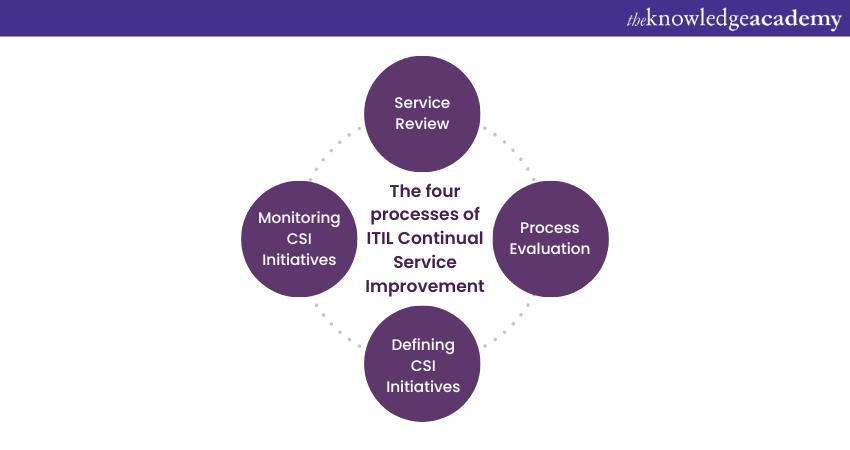
There are four processes of the ITIL Continual Service Improvement stage. They are presented below:
a) Service review: This process mainly aims to assess the services and infrastructure regularly. This assessment helps tweak the service quality where it is required. It also helps find practical and cost-effective ways to provide a service.
b) Process evaluation: This process aims to assess IT processes constantly. It helps to determine whether the metric process targets are achieved or not. Besides that, it allows benchmark metrics, reviews and assessments to be performed, and audits to be conducted.
c) Defining CSI initiatives: This process aims to optimise the services based on the analysis and evaluations by implementing certain initiatives. Some initiatives need customer input, while others are done internally and don't need customer suggestions.
d) Monitoring CSI initiatives: This process determines whether the initiatives for improvement go according to the plan.
Benefits of Continual Service Improvement:
In this section, you will learn the benefits of Continual Service Improvement:
a) CSI regularly monitor and improves IT services, so the overall customer satisfaction level will be high.
b) You can make well-informed decisions with CSI since it has a huge volume of data from previous work. This data also helps in forecasting events and processes.
c) It promotes more customer coordination and helps implement their feedback on the Service. This will improve customer satisfaction.
d) CSI proactively looks for new ways to improve your service efficiency.
Signup for ITIL® 4 Foundation Certification Training Course and fast-track your career in IT Service Management!
Benefits of applying ITIL Service Lifecycle
Understanding the advantages of applying to the ITIL Service Lifecycle is essential for organisations seeking improved service delivery. Let's explore some benefits of using this.
1) Well-defined approach: One of the primary benefits of using this framework is promoting transparency. It also includes a well-defined approach from start to finish, which helps streamline the process.
2) Continuous improvement: Continuous Improvement is crucial to using this framework. It helps organisations to analyse and improve their processes consistently.
3) Business alignment: One significant advantage of the ITIL Service Lifecycle is its ability to ensure that services are aligned with business goals.
4) Well-defined responsibilities: The ITIL Service Lifecycle framework follows the Responsible, Accountable, Consulted, and Informed (RACI) matrix, which helps clearly define everyone’s roles and responsibilities.
Conclusion
We hope you liked reading this blog and understood the 5 Stages of the ITIL Service Lifecycle in Detail. Apart from this, you would have also learned about the purpose and benefits of the five ITIL stages. If you're keen on solidifying your knowledge, exploring ITIL Interview Questions can provide valuable insights and further enhance your understanding of these stages.
Learn about various guiding principles of ITIL in Digital and IT strategy with our ITIL 4 Leader: Digital and IT Strategy DITS Course now!
Frequently Asked Questions

In the ITIL (Information Technology Infrastructure Library) framework, the service catalogue is a vital component that fits within the Service Strategy phase of the ITIL Service Lifecycle. The service catalogue is primarily developed and utilised during the Service Strategy phase. This phase focuses on defining the overarching strategy and objectives of IT Service Management to meet business needs and objectives effectively.

The objectives of the ITIL Service Lifecycle are to ensure alignment of IT services with business needs. It also aims to improve the quality of IT services, customer satisfaction and enable continual improvement of IT service delivery processes.

The Knowledge Academy takes global learning to new heights, offering over 30,000 online courses across 490+ locations in 220 countries. This expansive reach ensures accessibility and convenience for learners worldwide.
Alongside our diverse Online Course Catalogue, encompassing 17 major categories, we go the extra mile by providing a plethora of free educational Online Resources like News updates, Blogs, videos, webinars, and interview questions. Tailoring learning experiences further, professionals can maximise value with customisable Course Bundles of TKA.

The Knowledge Academy’s Knowledge Pass, a prepaid voucher, adds another layer of flexibility, allowing course bookings over a 12-month period. Join us on a journey where education knows no bounds.

Discover an array of ITIL Certification Courses at The Knowledge Academy, featuring specialised training in ITIL 4 Foundation, Support CDS, and High velocity IT Training. Designed for different skill levels, our courses provide the necessary technical expertise to meet ITIL Change Management.
Whether you're starting out or looking to upgrade your skills, immerse yourself in our IT Service Management Blogs for further understanding and expertise. Embark on a journey with us to elevate your ITIL Certification proficiency!
Upcoming IT Service Management Resources Batches & Dates
Date
 ITIL® 4 Foundation Certification Course
ITIL® 4 Foundation Certification Course
Mon 29th Jul 2024
Wed 31st Jul 2024
Mon 5th Aug 2024
Wed 7th Aug 2024
Sat 10th Aug 2024
Mon 12th Aug 2024
Wed 14th Aug 2024
Mon 19th Aug 2024
Wed 21st Aug 2024
Sat 24th Aug 2024
Tue 27th Aug 2024
Thu 29th Aug 2024
Mon 2nd Sep 2024
Wed 4th Sep 2024
Sat 7th Sep 2024
Mon 9th Sep 2024
Wed 11th Sep 2024
Mon 16th Sep 2024
Wed 18th Sep 2024
Sat 21st Sep 2024
Mon 23rd Sep 2024
Wed 25th Sep 2024
Mon 30th Sep 2024
Wed 2nd Oct 2024
Sat 5th Oct 2024
Mon 7th Oct 2024
Wed 9th Oct 2024
Mon 14th Oct 2024
Wed 16th Oct 2024
Sat 19th Oct 2024
Mon 21st Oct 2024
Wed 23rd Oct 2024
Mon 28th Oct 2024
Wed 30th Oct 2024
Sat 2nd Nov 2024
Mon 4th Nov 2024
Wed 6th Nov 2024
Mon 11th Nov 2024
Wed 13th Nov 2024
Sat 16th Nov 2024
Mon 18th Nov 2024
Wed 20th Nov 2024
Mon 25th Nov 2024
Wed 27th Nov 2024
Sat 30th Nov 2024
Mon 2nd Dec 2024
Wed 4th Dec 2024
Mon 9th Dec 2024
Wed 11th Dec 2024
Sat 14th Dec 2024
Mon 16th Dec 2024
Wed 18th Dec 2024
Mon 6th Jan 2025
Wed 8th Jan 2025
Mon 13th Jan 2025
Wed 15th Jan 2025
Mon 20th Jan 2025
Wed 22nd Jan 2025
Mon 27th Jan 2025
Wed 29th Jan 2025
Mon 3rd Feb 2025
Wed 5th Feb 2025
Mon 10th Feb 2025
Wed 12th Feb 2025
Mon 17th Feb 2025
Wed 19th Feb 2025
Mon 24th Feb 2025
Wed 26th Feb 2025
Mon 3rd Mar 2025
Wed 5th Mar 2025
Mon 10th Mar 2025
Wed 12th Mar 2025
Mon 17th Mar 2025
Wed 19th Mar 2025
Mon 24th Mar 2025
Wed 26th Mar 2025
Mon 31st Mar 2025
Wed 2nd Apr 2025
Mon 7th Apr 2025
Wed 9th Apr 2025
Mon 14th Apr 2025
Wed 16th Apr 2025
Tue 22nd Apr 2025
Mon 28th Apr 2025
Wed 30th Apr 2025
Tue 6th May 2025
Mon 12th May 2025
Wed 14th May 2025
Mon 19th May 2025
Wed 21st May 2025
Tue 27th May 2025
Mon 2nd Jun 2025
Wed 4th Jun 2025
Mon 9th Jun 2025
Wed 11th Jun 2025
Mon 16th Jun 2025
Wed 18th Jun 2025
Mon 23rd Jun 2025
Wed 25th Jun 2025
Mon 30th Jun 2025
Wed 2nd Jul 2025
Mon 7th Jul 2025
Wed 9th Jul 2025
Mon 14th Jul 2025
Wed 16th Jul 2025
Mon 21st Jul 2025
Wed 23rd Jul 2025
Mon 28th Jul 2025
Wed 30th Jul 2025
Mon 4th Aug 2025
Wed 6th Aug 2025
Mon 11th Aug 2025
Wed 13th Aug 2025
Mon 18th Aug 2025
Wed 20th Aug 2025
Mon 25th Aug 2025
Mon 1st Sep 2025
Wed 3rd Sep 2025
Mon 8th Sep 2025
Wed 10th Sep 2025
Mon 15th Sep 2025
Wed 17th Sep 2025
Mon 22nd Sep 2025
Wed 24th Sep 2025
Mon 29th Sep 2025
Wed 1st Oct 2025
Mon 6th Oct 2025
Wed 8th Oct 2025
Mon 13th Oct 2025
Wed 15th Oct 2025
Mon 20th Oct 2025
Wed 22nd Oct 2025
Mon 27th Oct 2025
Wed 29th Oct 2025
Mon 3rd Nov 2025
Wed 5th Nov 2025
Mon 10th Nov 2025
Wed 12th Nov 2025
Mon 17th Nov 2025
Wed 19th Nov 2025
Mon 24th Nov 2025
Wed 26th Nov 2025
Mon 1st Dec 2025
Wed 3rd Dec 2025
Mon 8th Dec 2025
Wed 10th Dec 2025
Mon 15th Dec 2025
Wed 17th Dec 2025







 Top Rated Course
Top Rated Course



 If you wish to make any changes to your course, please
If you wish to make any changes to your course, please


